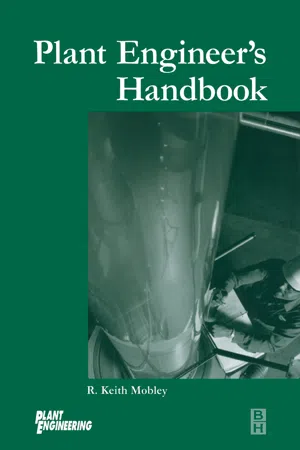
- 2,400 pages
- English
- ePUB (mobile friendly)
- Available on iOS & Android
Plant Engineer's Handbook
About this book
Plant engineers are responsible for a wide range of industrial activities, and may work in any industry. This means that breadth of knowledge required by such professionals is so wide that previous books addressing plant engineering have either been limited to only certain subjects or cursory in their treatment of topics. The Plant Engineering Handbook offers comprehensive coverage of an enormous range of subjects which are of vital interest to the plant engineer and anyone connected with industrial operations or maintenance.This handbook is packed with indispensable information, from defining just what a Plant Engineer actually does, through selection of a suitable site for a factory and provision of basic facilities (including boilers, electrical systems, water, HVAC systems, pumping systems and floors and finishes) to issues such as lubrication, corrosion, energy conservation, maintenance and materials handling as well as environmental considerations, insurance matters and financial concerns. One of the major features of this volume is its comprehensive treatment of the maintenance management function; in addition to chapters which outline the operation of the various plant equipment there is specialist advice on how to get the most out of that equipment and its operators. This will enable the reader to reap the rewards of more efficient operations, more effective employee contributions and in turn more profitable performance from the plant and the business to which it contributes.The Editor, Keith Mobley and the team of expert contributors, have practiced at the highest levels in leading corporations across the USA, Europe and the rest of the world. Produced in association with Plant Engineering magazine, this book will be a source of information for plant engineers in any industry worldwide.* A Flagship reference work for the Plant Engineering series* Provides comprehensive coverage on an enormous range of subjects vital to plant and industrial engineer* Includes an international perspective including dual units and regulations
Frequently asked questions
- Essential is ideal for learners and professionals who enjoy exploring a wide range of subjects. Access the Essential Library with 800,000+ trusted titles and best-sellers across business, personal growth, and the humanities. Includes unlimited reading time and Standard Read Aloud voice.
- Complete: Perfect for advanced learners and researchers needing full, unrestricted access. Unlock 1.4M+ books across hundreds of subjects, including academic and specialized titles. The Complete Plan also includes advanced features like Premium Read Aloud and Research Assistant.
Please note we cannot support devices running on iOS 13 and Android 7 or earlier. Learn more about using the app.
Information
1.1 Introduction
1.2 Basic Definition
Table of contents
- Cover image
- Title page
- Table of Contents
- Copyright
- Foreword
- Preface
- List of Contributors
- Chapter 1: Definition and Organization of the Plant Engineering Function
- Chapter 2: Plant Engineering in Britain
- Chapter 3: The Role of the Plant Engineer
- Chapter 4: Physical Considerations in Site Selection
- Chapter 5: Plant Location
- Chapter 6: Industrial Buildings
- Chapter 7: Planning and Plant Layout
- Chapter 8: Contracts and Specifications
- Chapter 9: Industrial Flooring
- Chapter 10: Lighting
- Chapter 11: Insulation
- Chapter 12: Paint Coatings for the Plant Engineer
- Chapter 13: Insurance: Plant and Equipment
- Chapter 14: Insurance: Buildings and Risks
- Chapter 15: Electricity Generation
- Chapter 16: Electrical Distribution and Installation
- Chapter 17: Electrical Instrumentation
- Chapter 18: Oil
- Chapter 19: Gas
- Chapter 20: Liquefied Petroleum Gas
- Chapter 21: Coal and Ash
- Chapter 22: Steam Utilization
- Chapter 23: Industrial Boilers
- Chapter 24: Combustion Equipment
- Chapter 25: Economizers
- Chapter 26: Heat Exchangers
- Chapter 27: Heating
- Chapter 28: Ventilation
- Chapter 29: Air Conditioning
- Chapter 30: Energy Conservation
- Chapter 31: Water and Effluents
- Chapter 32: Pumps and Pumping
- Chapter 33: Centrifugal Pump Installation
- Chapter 34: Cooling Towers
- Chapter 35: Compressed Air Systems
- Chapter 36: Compressors
- Chapter 37: Fans and Blowers
- Chapter 38: Mixers and Agitators
- Chapter 39: Gears and Gearboxes
- Chapter 40: Hydraulic Fundamentals
- Chapter 41: Pneumatic Fundamentals
- Chapter 42: Noise and Vibration
- Chapter 43: Vibration Fundamentals
- Chapter 44: Vibration Monitoring and Analysis
- Chapter 45: Air Pollution
- Chapter 46: Dust and Fume Control
- Chapter 47: Dust Collection Systems
- Chapter 48: Maintenance Management in UK
- Chapter 49: Effective Maintenance Management
- Chapter 50: Predictive Maintenance
- Chapter 51: Planning and Scheduling Outages
- Chapter 52: Lubrication
- Chapter 53: Corrosion
- Chapter 54: Shaft Alignment
- Chapter 55: Rotor Balancing
- Chapter 56: Packing and Seals
- Chapter 57: Gears and Gear Drives
- Chapter 58: Flexible Intermediate Drives
- Chapter 59: Couplings and Clutches
- Chapter 60: Bearings
- Chapter 61: Finance for the Plant Engineer
- Chapter 62: Statistical Approaches in Machinery Problem Solving
- Chapter 63: Health and Safety in the UK
- Chapter 64: Regulatory Compliance Issues in the US
- Index